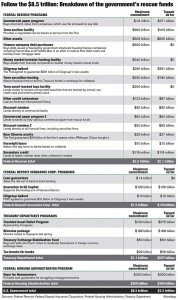Government Bailouts Estimated At $8.5 Trillion
 Bloomberg estimates that the government bailouts could total $8.5 trillion, which is about 60% of GDP. About $5.5 trillion comes from the Federal Reserve, about $1.1 trillion comes from Treasury, and the rest comes from the FDIC for banking issues and the FHA for housing issues. “Only” about $3.2 trillion has been used so far. As the San Francisco Chronicle put it:
Bloomberg estimates that the government bailouts could total $8.5 trillion, which is about 60% of GDP. About $5.5 trillion comes from the Federal Reserve, about $1.1 trillion comes from Treasury, and the rest comes from the FDIC for banking issues and the FHA for housing issues. “Only” about $3.2 trillion has been used so far. As the San Francisco Chronicle put it:
Given the unprecedented size and complexity of these programs and the fact that many have never been tried before, it’s impossible to predict how much they will cost taxpayers. The final cost won’t be known for many years.
They also included some highlights of the credit crisis in their story (below), as well as a discussion of where the funds are going. It’s worth the read:
Key dates in the federal government’s campaign to alleviate the economic crisis.
March 11: The Federal Reserve announces a rescue package to provide up to $200 billion in loans to banks and investment houses and let them put up risky mortgage-backed securities as collateral.
March 16: The Fed provides a $29 billion loan to JPMorgan Chase & Co. as part of its purchase of investment bank Bear Stearns.
July 30: President Bush signs a housing bill including $300 billion in new loan authority for the government to back cheaper mortgages for troubled homeowners.
Sept. 7: The Treasury takes over mortgage giants Fannie Mae and Freddie Mac, putting them into a conservatorship and pledging up to $200 billion to back their assets.
Sept. 16: The Fed injects $85 billion into the failing American International Group, one of the world’s largest insurance companies.
Sept. 16: The Fed pumps $70 billion more into the nation’s financial system to help ease credit stresses.
Sept. 19: The Treasury temporarily guarantees money market funds against losses up to $50 billion.
Oct. 3: President Bush signs the $700 billion economic bailout package. Treasury Secretary Henry Paulson says the money will be used to buy distressed mortgage-related securities from banks.
Oct. 6: The Fed increases a short-term loan program, saying it is boosting short-term lending to banks to $150 billion.
Oct. 7: The Fed says it will start buying unsecured short-term debt from companies, and says that up to $1.3 trillion of the debt may qualify for the program.
Oct. 8: The Fed agrees to lend AIG $37.8 billion more, bringing total to about $123 billion.
Oct. 14: The Treasury says it will use $250 billion of the $700 billion bailout to inject capital into the banks, with $125 billion provided to nine of the largest.
Oct. 14: The FDIC says it will temporarily guarantee up to a total of $1.4 trillion in loans between banks.
Oct. 21: The Fed says it will provide up to $540 billion in financing to provide liquidity for money market mutual funds.
Nov. 10: The Treasury and Fed replace the two loans provided to AIG with a $150 billion aid package that includes an infusion of $40 billion from the government’s bailout fund.
Nov. 12: Paulson says the government will not buy distressed mortgage-related assets, but instead will concentrate on injecting capital into banks.
Nov. 17: Treasury says it has provided $33.6 billion in capital to another 21 banks. So far, the government has invested $158.6 billion in 30 banks.
Sunday: The Treasury says it will invest $20 billion in Citigroup Inc., on top of $25 billion provided Oct. 14. The Treasury, Fed and FDIC also pledge to backstop large losses Citigroup might absorb on $306 billion in real estate-related assets.
Tuesday: The Fed says it will purchase up to $600 billion more in mortgage-related assets and will lend up to $200 billion to the holders of securities backed by various types of consumer loans.
